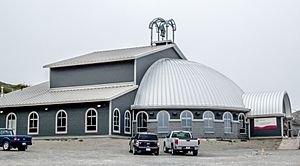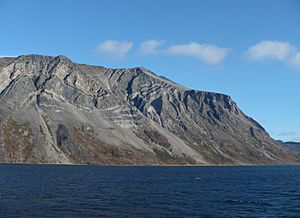Nunatsiavut facts for kids
Quick facts for kids
Nunatsiavut
|
|||
|---|---|---|---|
|
Autonomous area
|
|||
|
|||
| Anthem: Labradorimiut | |||

Nunatsiavut's location in Newfoundland and Labrador, Canada
|
|||
| Country | Canada | ||
| Province | Newfoundland and Labrador | ||
| Created | June 23, 2005 | ||
| Capital | Hopedale (legislative) Nain (administrative) |
||
| Government | |||
| • Type | Consensus government within the parliamentary system of Canada | ||
| • Body | Nunatsiavut Assembly (Nunatsiavut katimajitsuangit) | ||
| Area | |||
| • Total | 66,787.13 km2 (25,786.66 sq mi) | ||
| • Officially | 15,800 km2 (6,100 sq mi) | ||
| Population
(2021)
|
|||
| • Total | 2,323 | ||
| • Density | 0.035/km2 (0.09/sq mi) | ||
| Time zone | UTC−04:00 (AST) | ||
| Postal code prefix |
A0P
|
||
| ISO 3166 code | NL | ||
| Federal riding | Labrador (electoral district) | ||
| Provincial riding | Torngat Mountains (electoral district) | ||
| Website | nunatsiavut.com | ||
Nunatsiavut (/nuːˈnɑːtsiəvʊt/; Inuktitut: ᓄᓇᑦᓯᐊᕗᑦ) is a special self-governing area in Newfoundland and Labrador, Canada. It is claimed by the Inuit people. This area includes land in Labrador that reaches all the way to the Quebec border.
In 2002, the Labrador Inuit Association suggested that the Inuit should have more control over their own affairs. This idea led to the creation of Nunatsiavut. The new government was officially set up on December 1, 2005. It is in charge of things like health, education, and culture for the Inuit people. It also organizes elections for its leaders. The current president is Johannes Lampe, who started his role in 2016.
In the Inuktitut language, Nunatsiavut means "Our Beautiful Land." This name was chosen to show the importance of the land to the Inuit. A main goal of Nunatsiavut's self-governance is to protect the Inuit culture and language. It also aims to care for the environment.
Contents
How Nunatsiavut Governs Itself
The Labrador Inuit Association started asking for land rights in Labrador back in 1977. In 1988, they began talking with the governments of Newfoundland and Canada. They wanted to reach an agreement about the land. By 2001, they had a basic agreement. In 2004, over 75% of the Inuit people voted to approve it.
On January 22, 2005, the Inuit of Nunatsiavut signed the Labrador Inuit Lands Claims Agreement. This was a big step! It gave them special rights over a large area of land, about 72,520 square kilometers. This area includes the northern part of Labrador and some of the Atlantic coast. The agreement also gave them rights over 44,030 square kilometers of sea.
While the Inuit do not own all this land, they have special rights for traditional land use. They officially own 15,800 square kilometers of land, called Labrador Inuit Lands. The agreement also helped create the Torngat Mountains National Park in the northern part of the land.
This agreement is a treaty between the Inuit of Labrador and the governments. It is protected by Canada's Constitution. This means it is a very important and lasting agreement.
The self-governance agreement also included money from the Canadian government. This money helped set up the new government and provided payments for natural resources. It also included land, mineral, and marine rights for the Inuit.
The agreement was approved by the Labrador Inuit, the government of Newfoundland and Labrador, and the Parliament of Canada. It became official on June 23, 2005.
On December 1, 2005, the Nunatsiavut government officially began. Power was transferred from the provincial government to the new Inuit government. They could now make their own laws about culture, education, and health.
In October 2006, Nunatsiavut held its first election. Nine members were chosen to form the new government. They were sworn in on October 16 in Hopedale.
The Nunatsiavut government is also working to take over child protection services. This means they want to care for Inuit children in a way that respects their culture.
Nunatsiavut Assembly and Executive Council

The land claim agreement created the Government of Nunatsiavut. This government represents the people living in the area and Inuit living elsewhere in Canada. Nunatsiavut is still part of Newfoundland and Labrador. However, its government has power over health, education, and justice in its land.
Nunatsiavut uses a consensus government system. This means leaders work together to make decisions. The main law-making body is in Hopedale. The administrative offices are in Nain.
The Nunatsiavut Assembly has at least 16 members. These include:
- A president, who leads the Nunatsiavut Executive Council.
- Ten regular members from different communities and areas.
- The Angajukĸâk (mayor) from each of the five Inuit Community Governments.
- The Chairs of the Inuit Community Corporations.
Currently, there are 18 members in the Assembly. From these members, a First Minister is chosen. The Assembly discusses laws and watches over the Executive Council.
The Nunatsiavut Executive Council is chosen by the First Minister. This council puts laws into action and creates new policies. They also manage the government and are responsible to the Assembly.
Inuit Community Governments were set up in Nain, Hopedale, Makkovik, Postville, and Rigolet. Each has a council elected by both Inuit and non-Inuit residents. An Angajukĸâk, who must be Inuk, leads each council.
Large groups of Labrador Inuit living outside the main area are represented by Inuit Community Corporations. The Angajukĸâk and the chairperson of each corporation represent their communities in the Nunatsiavut Assembly.
Government Departments
The Nunatsiavut government has seven departments. These are led by six ministers. The Nunatsiavut Secretariat is led by the President of the Executive Council.
- Department of Finance, Human Resources and Information Technology
- Department of Education and Economic Development
- Department of Culture, Recreation and Tourism
- Department of Health & Social Development
- Department of Lands and Natural Resources
- Department of Nunatsiavut Affairs
- Nunatsiavut Secretariat
Government Buildings
Each community has its own government buildings. The main administrative office is in Nain. It is located at 25 Ikajuktauvik Road.
The Nunatsiavut Assembly meets in the Nunatsiavut Assembly Building in Hopedale. This building opened in 2012. It is the first permanent home for the Assembly since 2008.
Geography of Nunatsiavut
Nunatsiavut's land claim includes the area around Hamilton Inlet. It also covers the coastline north to a point south of Davis Inlet. The Mulligan River forms part of its boundary. The land also goes north from the Notakwanon River to Cape Chidley. Nunatsiavut is the most southern Inuit territory in Canada.
Nunatsiavut has two main geographic parts. The southern part includes Rigolet, Makkovik, Postville, and Hopedale. In 2016, about 1,433 people lived there. The northern part has Nain and the Torngat Mountains National Park.
Nunatsiavut is close to other communities. These include the Innu communities of Natuashish and Sheshatshiu. It is also near North West River, Happy Valley-Goose Bay, and Cartwright. In Quebec, nearby settlements are Kuujjuaq and Kangiqsualujjuaq.
Towns of Nunatsiavut
The five main towns in Nunatsiavut are:
- Hopedale
- Makkovik
- Nain
- Postville
- Rigolet
People and Languages
In 2021, the population of Nunatsiavut was 2,323 people. Most people in Nunatsiavut speak English. In 2016, 98.8% of residents spoke English. A small number also speak French.
Ethnic Backgrounds
Most people in Nunatsiavut have Indigenous ancestry. In 2016, 91.8% of residents were Indigenous Canadians. Of these, 2,290 were Inuit. There were also 35 Métis and 25 First Nations people.
Nunatsiavut recognizes two main groups of people: Inuit and Kablunângajuit.
Kablunângajuit People
The Nunatsiavut government defines Kablunângajuk as someone recognized by Inuit customs. This often means a person of mixed Inuit and non-Inuit background. It can also refer to non-Inuit who settled in Nunatsiavut before 1940. Their ancestors were often fur traders from places like Quebec, Scotland, and Norway. These traders often married Inuit people.
The word Kablunângajuk means "person who resembles a white person." In the past, they were sometimes called "settlers" or "half-breeds." As beneficiaries of Nunatsiavut, Kablunângajuit have the same rights as Inuit beneficiaries in the region.
Transportation in Nunatsiavut
A ferry called the MV Kamutik W connects Nunatsiavut's five communities. It also travels to other nearby places like Natuashish and Happy Valley-Goose Bay. Before 2019, the MV Northern Ranger provided this service.
All five communities also have airports. PAL Airlines provides flights to these airports. There are no roads connecting the communities in Nunatsiavut to the main road system. However, there have been ideas to connect Nunatsiavut to the Trans-Labrador Highway.
Notable People from Nunatsiavut
- Caubvick, a person whose name is used for Mount Caubvick.
- Randy Edmunds, a former member of the Newfoundland and Labrador House of Assembly.
- Johannes Lampe, the current President of Nunatsiavut.
- Sarah Leo, a former President of Nunatsiavut.
- Mikak, one of the first Inuit to travel to Europe and return in the 1700s.
- Natan Obed, the President of the Inuit Tapiriit Kanatami.
- Keith Russell, a former politician.
- John Shiwak, a soldier.
- Abraham Ulrikab, a former resident of Hebron.
- Marlene Winters-Wheeler, a speaker of the Nunatsiavut Assembly.
See also
 In Spanish: Nunatsiavut para niños
In Spanish: Nunatsiavut para niños
- List of proposed provinces and territories of Canada
- Nunatsiavut Assembly




